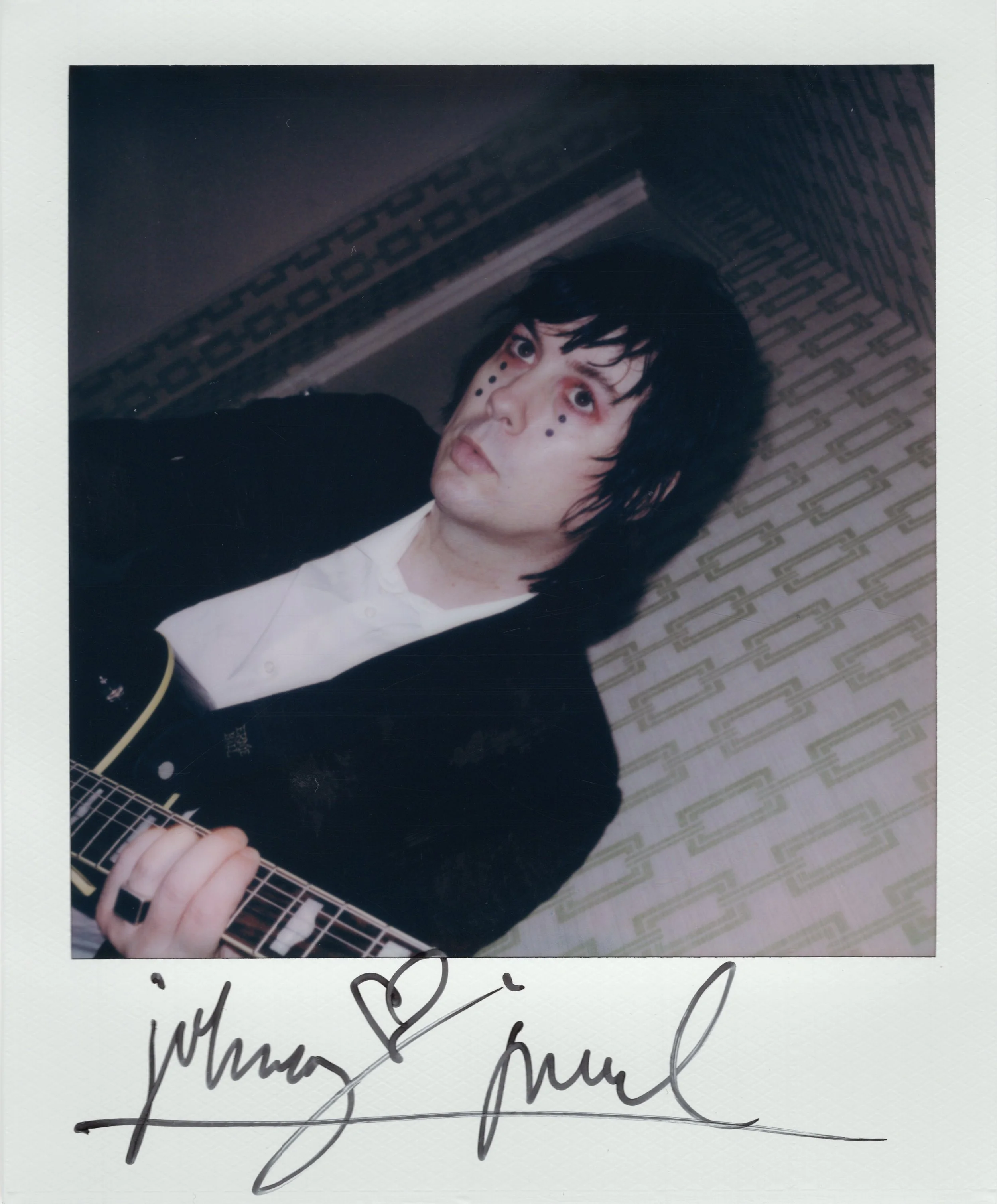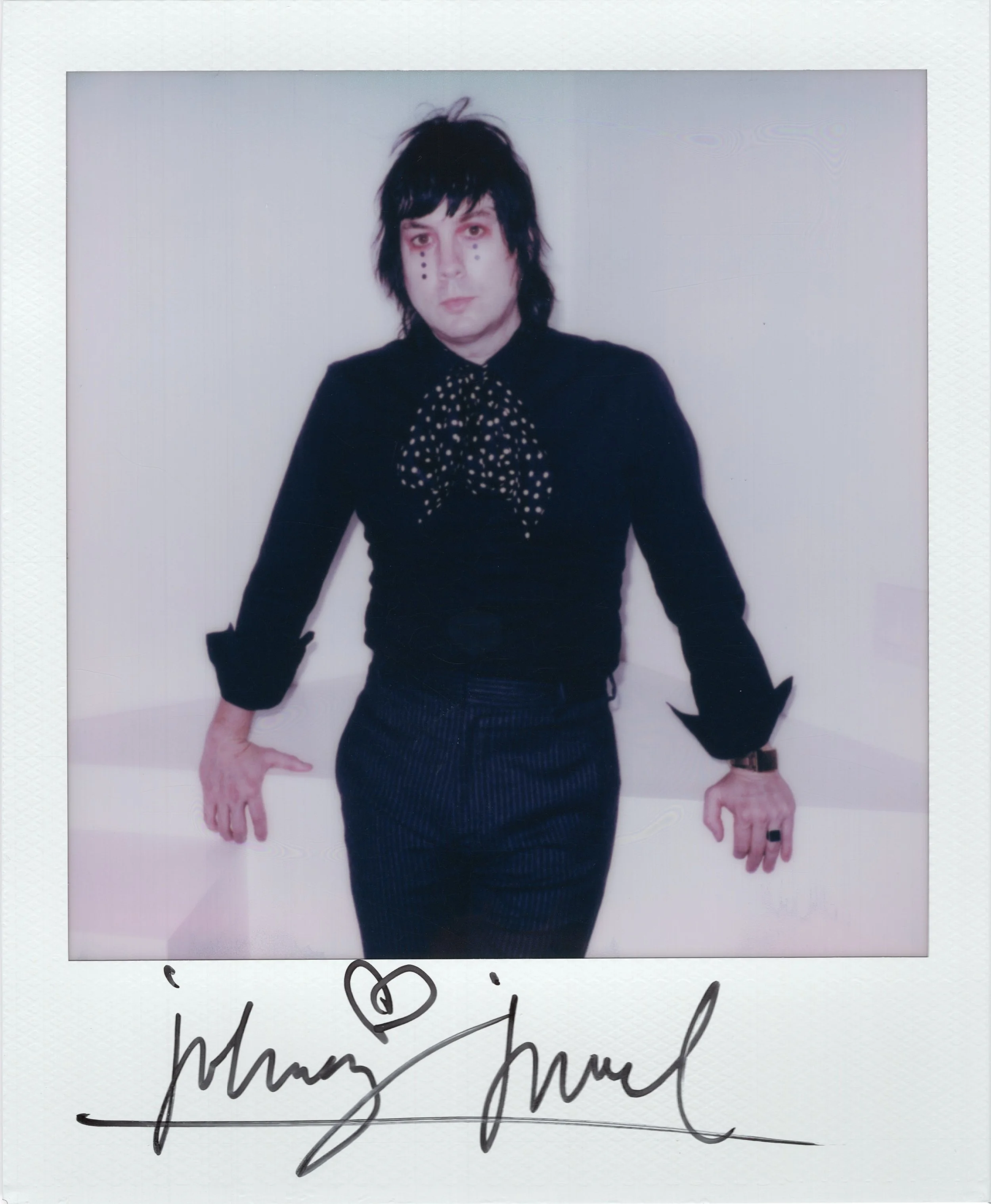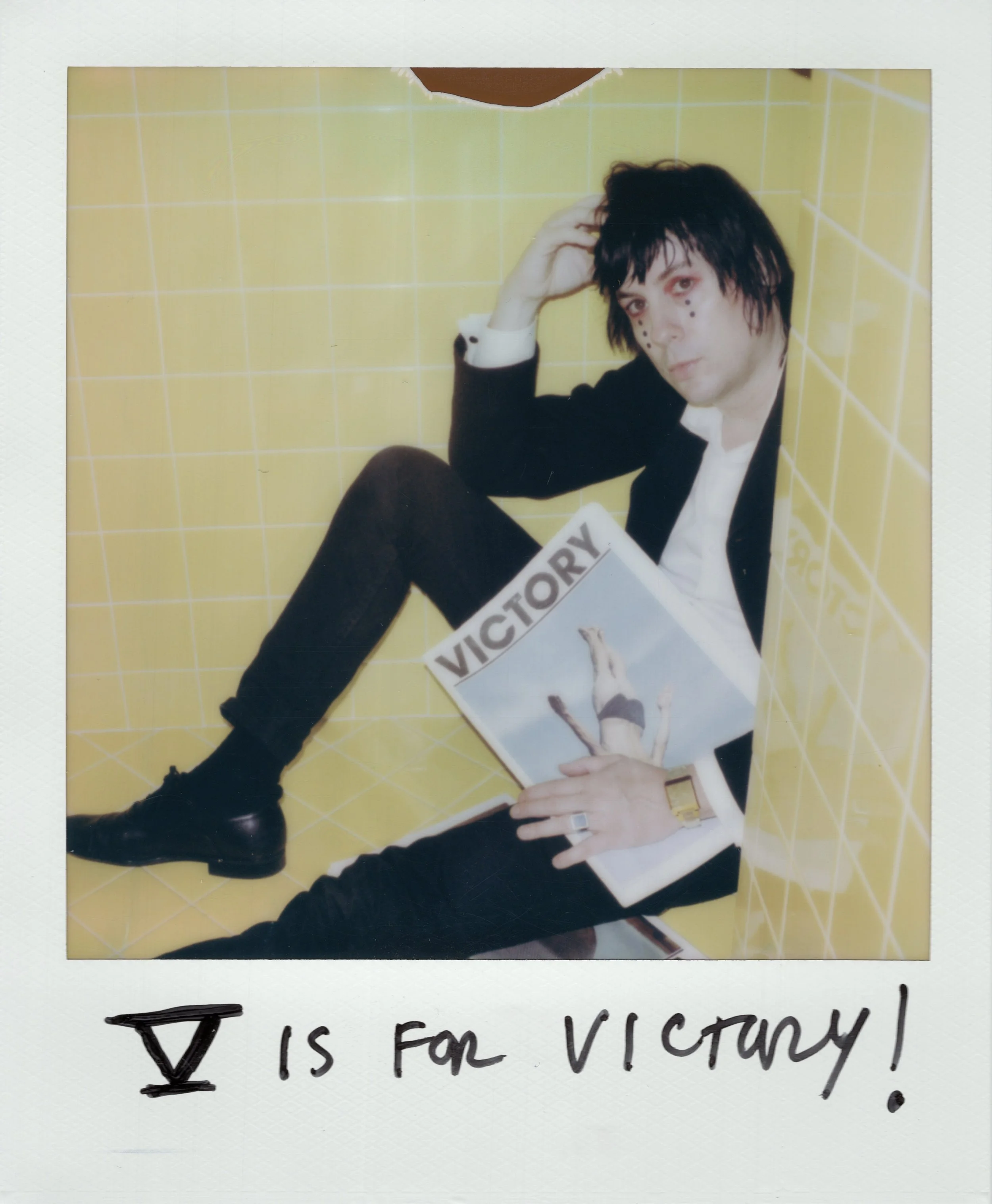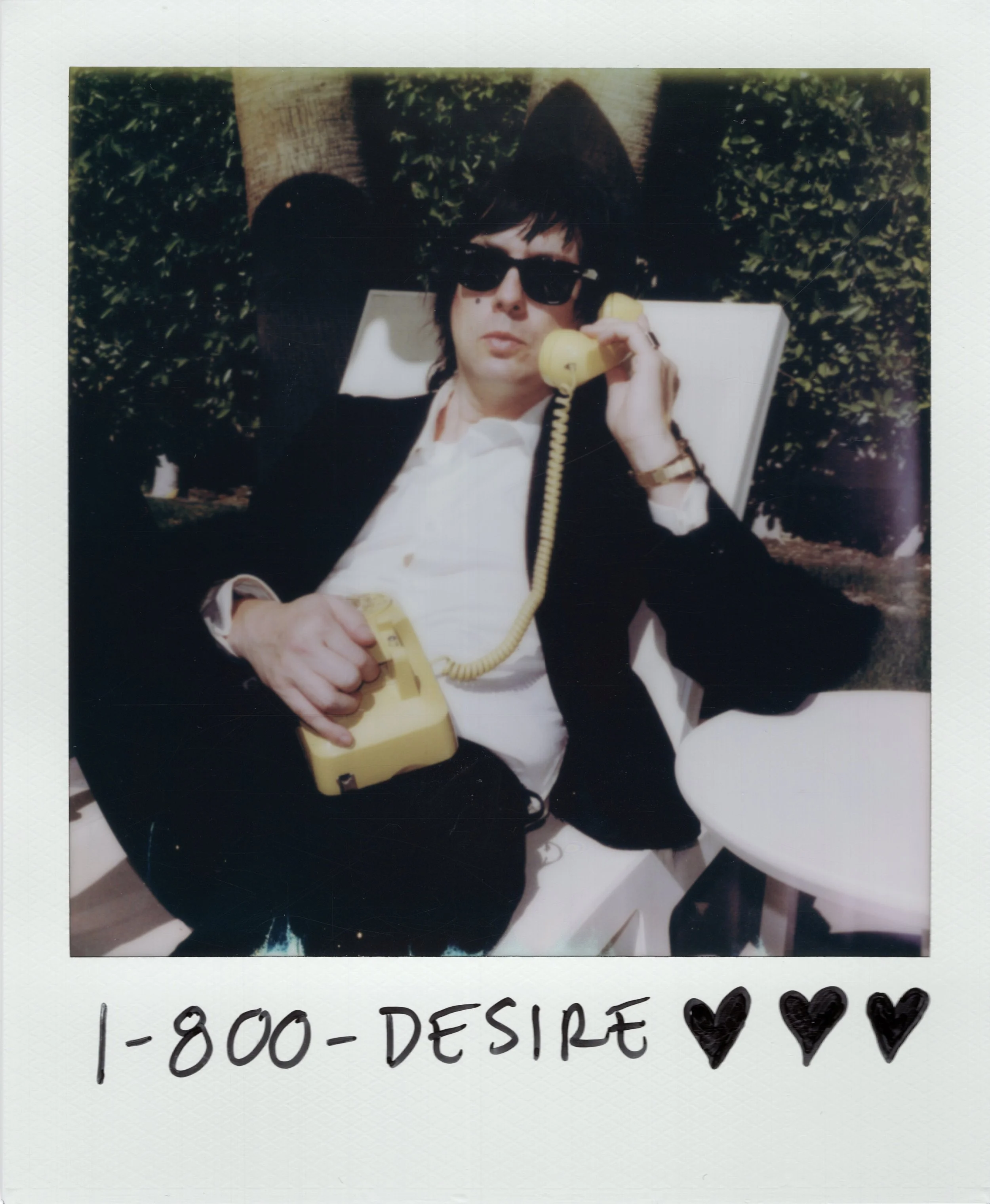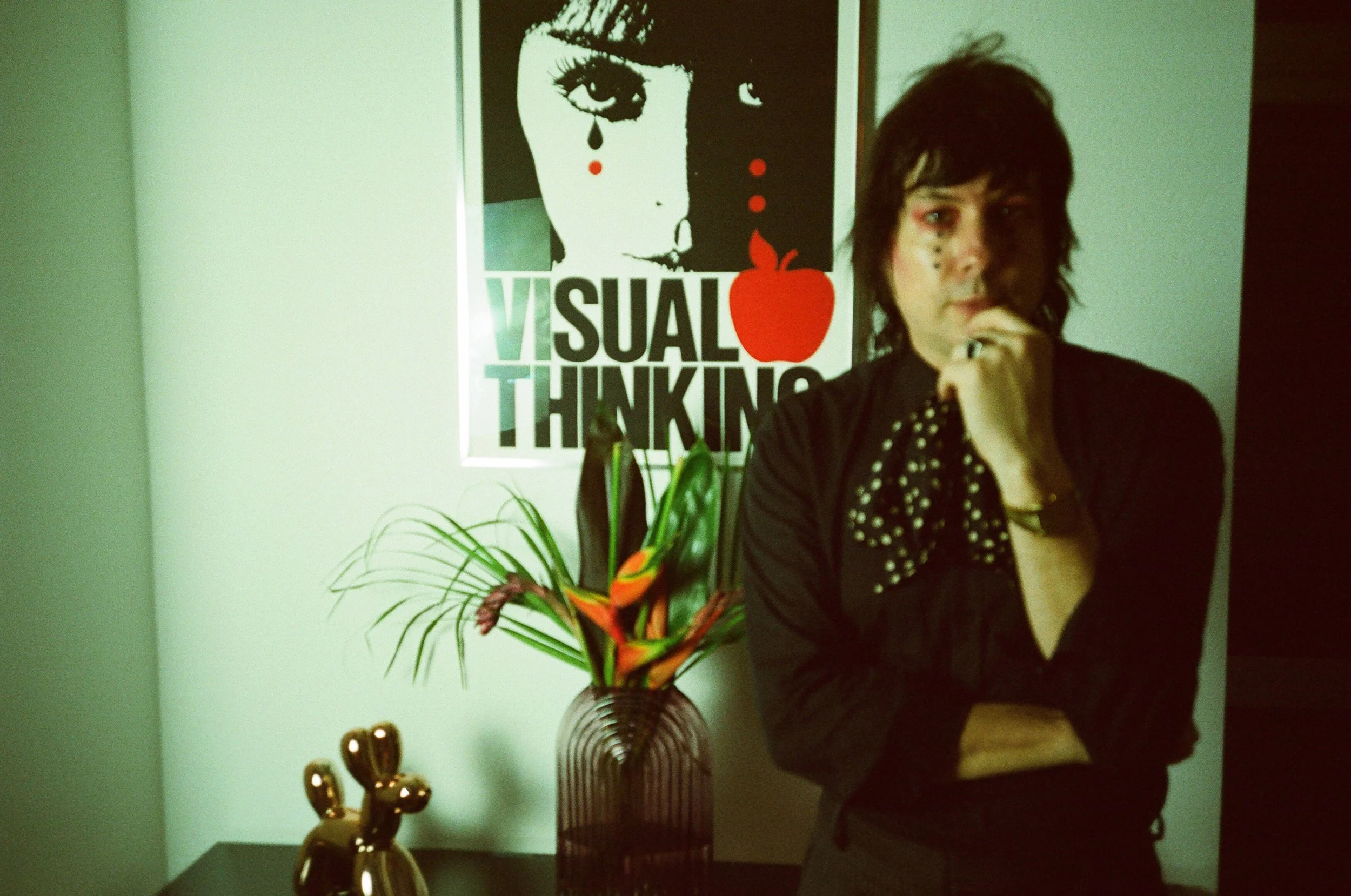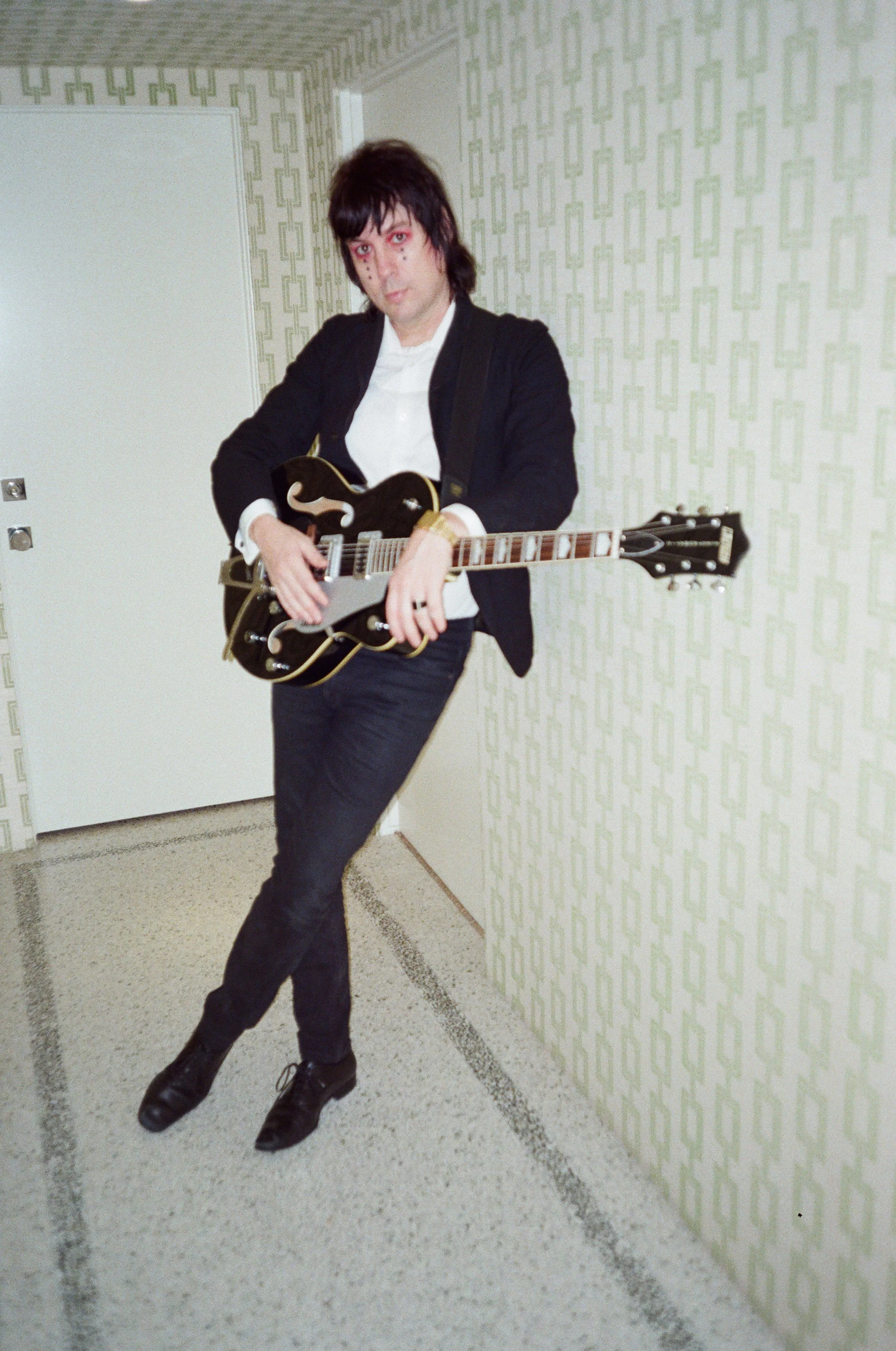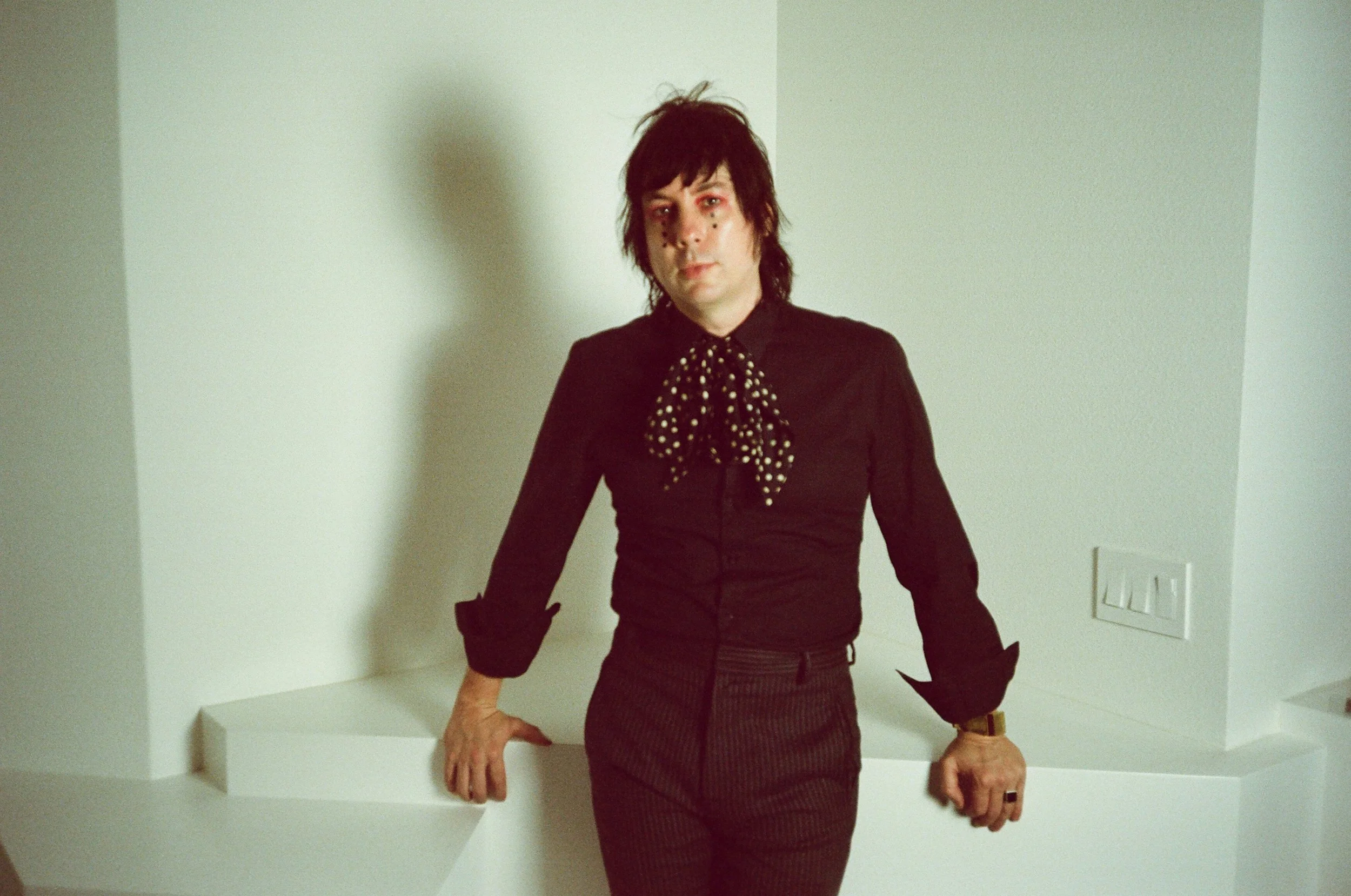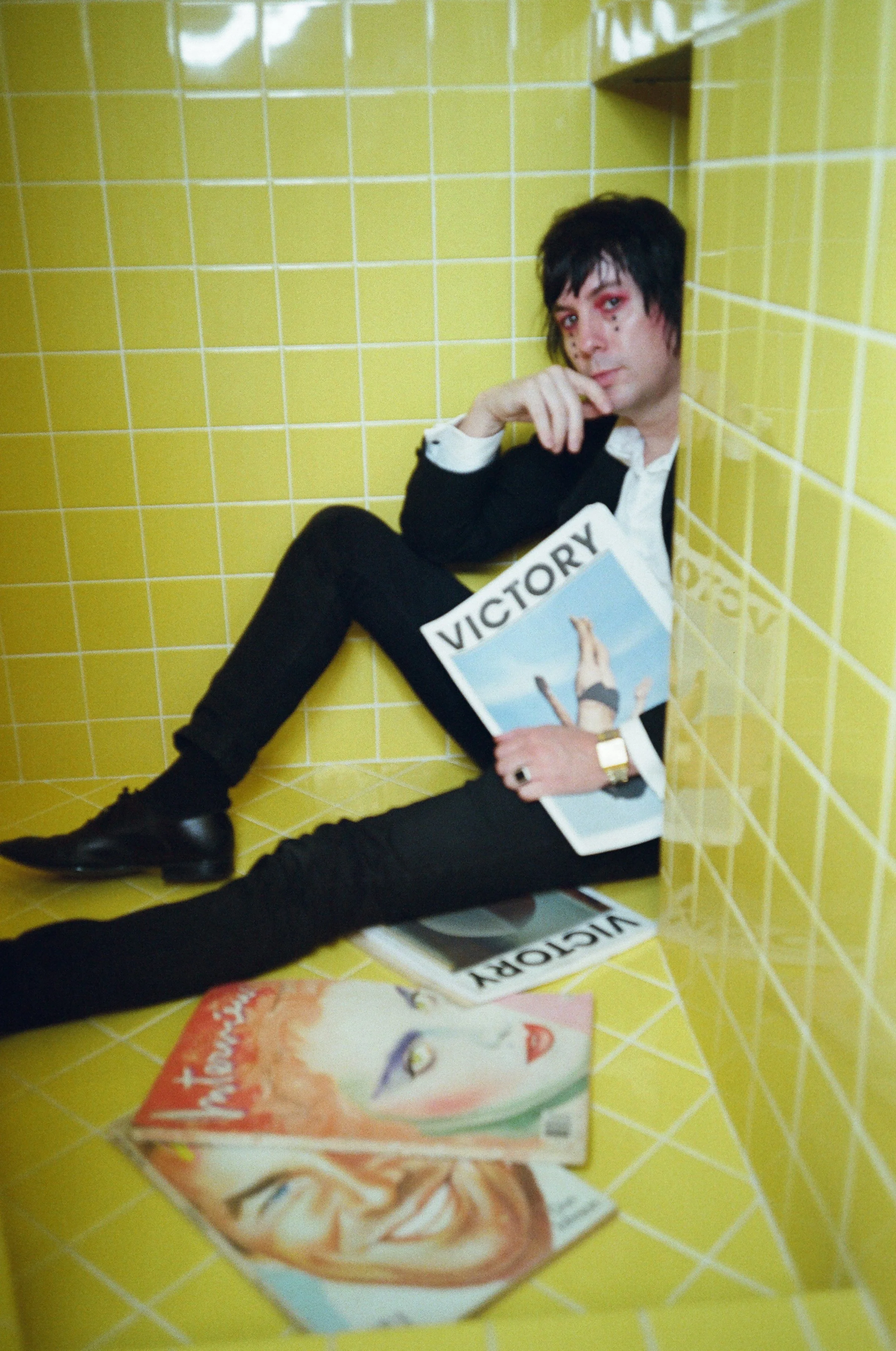Twelve Hours in the Desert with Johnny Jewel
For millennia, much has been written about the living poetry of the desert. Exhausting yet inspiring, taxing yet rewarding, its beauty is one both rare and hard-earned. The desert is complex and mysterious and possesses the aforementioned beauty in spite of —or possibly because of— the hardships it faces and survives. The desert’s punishing sunlight can make walking outside nigh unbearable, but this is of course the same illuminating force that transforms the palm trees into majestic shimmering towers that dot the remarkable landscape — a reminder that the formidable region does indeed bestow boons upon the hearty spirits patient and resilient enough to endure its trials.
It was fitting, then, that the desert was the backdrop for our recent extended meeting with Johnny Jewel. Not only does this storied setting mirror Jewel’s personal and creative journey, but it is also the place he has happily decided to call home in recent years. And similar to his adopted habitat, there is a pervading sense of mystery to Johnny Jewel which stands in stark relief to his disarmingly genuine, warm, and empathetic demeanor.
Hot on the heels of the announcement that Johnny Jewel will soon be playing his first-ever solo performances, we gratefully embraced the opportunity to document an in-person discussion with him. Starting mid-day and lasting into the next, the conversation (both on and off record, including a new collaborative photo shoot) was as illuminating as it was inspiring, simultaneously ultra-detailed and universal as our ranging discussion straddled both micro and macrocosms. We are honored to share our experience here, which we will forever remember as Twelve Hours in the Desert with Johnny Jewel.
Bobby Weirdo: There are going to be Johnny Jewel solo shows in Los Angeles and London. Is this the first time that you’ve played a show billed as a Johnny Jewel solo performance?
Johnny Jewel: Yes — first time ever. I was asked to play an experimental music festival in Belgium in 2001 for some of my 90s records at this festival called KRAAK Festival. When I went to get my passport, I thought it would be great if I wore full makeup, so I got all dolled up and got my passport photo taken. Then 9/11 happened.
Maybe it was the makeup, maybe it was Homeland Security's overreaching hand – I don’t know, but my passport application was rejected. For the next five years I had trouble getting a passport because I was flagged on a watch list. Ultimately, I finally got a passport in 2008 and started touring outside the continental U.S., but it all started with trying to do that solo show in Belgium.
I had built some concepts and treatments for that show that I had always wanted to do live, so I’ll be using some of those techniques for the film score pieces.
BW: So, will the bulk of the material you’ll be performing be soundtrack material, ambient music, or actual songs with you singing that we might not have heard [before]?
JJ: I’m still developing what I’m going to play. At this point, I have about six weeks to decide what I’m going to play at the Hollywood Forever show. As of right now it’s a mix — I have about ten to twelve things in the running for main pieces that have been released. Some of them are more well-known than others. Some of them are film scores; some of them are from solo albums.
And then I have seven or eight pieces that are in secondary running for transitional interludes or smaller segments of music that are unreleased. Within that, some of it is work for a new solo record and some are essentially elements of improvisation that I’m going to explore live. The overall performance is a mix of well-known pieces from Drive, Twin Peaks, Lost River, Bronson… those will be more traditional interpretations of the released music that people know in association with those films. Within that, there’s a level of improvisation. Then there’s complete improvisation in the new work that is going to be explored.
I prefer working things out live before finalizing a released version if possible. I have never really had that opportunity on my solo work, so I’m really interested in doing a few shows: Hollywood Forever, London, a museum in Oslo, a festival in Paris. By the time I come back from doing these shows, I will have explored these newer pieces in front of an audience, and that will inform where I take the released work eventually.
BW: Looking at you performing your music, it strikes me as a listener that the female voice has been important to you in actualizing your vision – Ida, Ruth, Megan, Farah, Orion, Joon, and Glüme, among others. Is there something about the female voice that is intrinsic to your vision, and how does that affect shows where you might be singing, and don’t have that female voice?
JJ: I think women are superior to men in every imaginable way, and I find working on music with women — vocally and musically — to be endlessly inspiring and fascinating because it’s so different than my own perspective. It’s just a magnetism thing.
For vocals, I have an experiment planned but I don’t want to spoil it. So, I won't talk about that. I am going to be doing some live vocoder and I have a concept that I am testing right now for some of the other vocal moments. I am going to implement spoken word into the set as well.
There will be moments of Pop, but primarily the focus will be vocal as a texture; as a human or semi-human cognitive presence within instrumental pieces. Some type of voice-like presence – whether it’s synthesized, vocoded, or some other method will occasionally cameo.
BW: Going back into the history of Johnny Jewel, a stranger in New Orleans gave you that name, correct?
JJ: Yes, she did. I don’t know her name.
BW: You were just walking down the street?
JJ: I was in Houston visiting my mother, and my friends Get Hustle were in town. They drove through Houston and were on their way to New Orleans, so I rode in the van with them. I was at the club while they were sound checking, and I went outside to take a walk around. There was a woman outside; I think she was homeless. I started talking with her and we hit it off pretty well. After a while, she asked me what my name was, and I said “Johnny.” She said, “Johnny what?”, and I said, “I don’t know.” She said, “Well, I’m going to call you Johnny Jewel.”
I laughed about it and didn’t think too much of it. It was just a fun moment — she was really sweet. She probably called me that because I was wearing a really ornate pink rhinestone necklace that was almost like a scarf. I was in full Spiders from Mars regalia, head to toe: makeup, bell bottoms, platform shoes, woman’s blouse. I was very sparkly.
She called Johnny Jewel, and I was telling people that story because it was a fond memory from that trip. Then it just kind of slowly stuck. I heard later that it was the name of a cartoon from the 1940s which might be what Tom Verlaine was referring to in the Television song. But for me personally it’s unrelated to Television, other than maybe it originates from the cartoon. The woman was maybe 70, so my guess is that she knew the cartoon.
BW: Was your friend in Get Hustle David Scott Stone, or was it someone else?
JJ: He was not on that tour. David was on a West Coast tour; I saw them when they first came to Portland and played at a place called 17 Nautical Miles. It was the first Glass Candy show in 1999 — there were about ten people there but the show was really amazing. He was on that tour.
For this tour, it was Maxamillion the drummer, Mac the piano player, Valentine the singer, and Mark — who goes by Evan now — as the second keyboardist-slash-organ player. He was Glass Candy’s first drummer so we’re all kind of related. And Mac and Valentine were living with Ida and I in Portland around that time.
BW: Although you have a signature sound, you’ve gone through so many iterations with your music. Would there ever be a reason at this point to create an alter ego for Johnny Jewel, or do you feel comfortable filing everything you do under “Johnny Jewel”, regardless of personnel, genre…
JJ: Well, I have Mirage. I’m working on the first Mirage album; it’s been in the works since 2005. I consider the vocal music that I make with the vocoder and computer voicing an alter ego. For my own music and music I make with other people, “Johnny Jewel” is fine. This conversation came up when I started scoring films, because composers don’t usually use stage names, but I decided to keep my stage name the same as my composer name instead of using my given name. I'll most likely be keeping it, even though it’s a playful name.
BW: I’m looking at you now, and you have dots under your eyes. In the past, I’ve counted three under your right and two under your left, one under your right and two under your left, two under each eye, one under each eye…is it always random and spur-of-the-moment or is there a meaning behind the number of dots there are under each eye?
JJ: If you’re seeing any other dot formations, it’s because of sweat and tears. The dots have a tendency to disappear. But it’s always two under the left eye, three under the right. I often do mirror images of photos of myself because I only view the dots in the mirror. When I see photos of how you see the dots, it looks reversed to me. Sometimes I’ll flip images because of this.
The meaning of the dots is that they represent people in my life from the past that — for one reason or another — are no longer part of my life. They either transitioned into the great unknown or are just gone, but they are people who had monumental impact on me at a crossroads in my life. I’ll just say that — otherwise I’m going to start crying.
BW: What – if anything – is Houston about Johnny Jewel? Going outside the typical Italians wheelhouse — at least on the surface — is the legacy of artists like DJ Screw or Geto Boys any part of what you became [artistically]?
JJ: With Robert Davis — who is DJ Screw — we grew up around the same age, listening to the same radio stations in Houston. There’s a similarity in terms of things we would have been exposed to musically. I really connected with DJ Screw’s mix of R ‘n’ B and slowed-down funk.
As a teenager, I would intentionally buy 45s at Goodwill and listen to them on 33 rpm, which everyone always found really annoying. But I liked how the sound was stretched out and I’d never heard anybody really appreciating that until I heard DJ Screw, which was strange. I don’t know if that has something to do with Houston or what, and I’m not comparing myself to him in any way; that’s just a similarity. We come from a similar era in that specific city and we’re a similar age. So, there’s that. What he did is nothing short of genius.
In general, my personal experience was that there was this really oppressive feeling in Houston. For me, that feeling was lonely. There was a sense of oppression in the culture and environment within the church and socio-economic situations I was in, with limited access to resources or other things. I always had food and clothes; my mom always took good care of me. But I was definitely left feeling like I wasn’t connecting, which is a little ironic because I do still feel like Houston is the center of the Universe.
I don’t know if it’s like that for you for where you’re from, but the blades of grass, the way the rain smells when it hits the pavement — that feels normal to me. It feels right; it feels accurate. Everywhere else feels transitional or temporary, but Texas feels real and tangible. It’s like the repetition of all those sensations through the years of growing up and developing cemented in your brain and memory; all these sensory-associated things. Even if I don’t connect with it in a social way, Houston still feels more like home than anywhere else.
I will say — and I think you know this about me — that I love Jandek. Corwood Industries is from Houston and that had a massive impact on me visually, discovering Jandek in high school at the record stores – specifically Sound Exchange which isn’t there anymore. That store always had a Jandek section which was always fully sealed. Corwood records were $3.99 and nobody ever bought them, or they would constantly stock them — one of the two. I don’t know which, but they were always there.
Anytime I could get to Sound Exchange, I would pick up a Jandek record. Musically I love it, but for me it’s almost more like looking at a painting than listening to an album. The cover art and the back-cover typography is limitless. When I look at it, it’s so inspiring, like watching a film. That had a massive impact on my desire to use mystery in art direction.
Even though typography is a very big part of what I do visually, generally leaning away from typography on album covers was inspired by Jandek. That’s not such an unusual thing these days, but when I started designing records in the mid and late 90s and early 2000s, that was an unusual thing. Every band had their logo and the album name on the cover because it was all about the record label making the point of sale on the shelf and you knowing exactly what that record was. Only the big bands like Led Zeppelin would do something really obscure, because they were so big that they could be mysterious and people would discover it anyways. But for the smaller bands, that was the go-to method to get the word out — this is the band name; this is the band logo. The Corwood records were really defiant in that respect, and completely alien to everything else I was seeing on the shelves that was new. It’s impossible to overestimate the impact that had on me.
BW: You paid a lot of dues, including working at the Fiesta supermarket, which had a mariachi band playing all day every day at the checkout. You were also a test subject at the pharmaceutical company where Robert Rodriguez also went. Were you pursuing those ways of making money with a goal or finish line in mind for music or how you wanted to live your life? Or were you taking those things a day at a time at that point, just making ends meet?
JJ: Working at the grocery store in Houston that you mentioned —Fiesta — was so that I could have enough money to go to the skate park on the weekends and get to see people like John Gibson or Jeff Phillips skate, which was just incredible. This was Houston in the late 80s / early 90s and I worked there for about six months just as a means to an end to buy skateboards or go to the skate park.
After that, I got a job at Kroger, which was a different grocery store, and the purpose of that one was so I could buy a 4-track. The 4-track was about $400 new at the time, and I was hired at $2.85 an hour, which was not very much money. It was really difficult to save up.
Fast-forward to Pharmaco, which is the place you’re talking about in Austin with the experimental medical studies. The purpose of that was to buy synthesizers, and that would have been ’94 / ’95 era. It was day-to-day in the sense that at that point I really did not want to have a job.
I had been working at a Circle K in Austin, and I had been robbed several times in a violent manner. I worked the night shift alone on the outskirts of town, and I started becoming a little bit paranoid about going to work. So I quit, but then I needed food, I needed to pay rent, and I wanted to buy synthesizers.
This guy Todd gave me a place to live. He lived upstairs and I lived downstairs. It was a small garage of an upstairs apartment. Inside the garage were all broken-down Xerox machines for a Kinko’s type place called Ginny’s in Austin. Todd was my friend, but he was also my landlord and released my first noise double album in '95. He worked at Ginny’s on the nightshift and he would let me make endless free copies for zines. I just had to pay him $100 rent to stay in the room with all the printers and make as much noise as I wanted.
I put a futon on top of the printers, slept there, and recorded my first album. One of the things I recorded the album with was the 4-track that I bought with the money from Kroger in Houston. The synthesizer was a Moog Opus 3. I was able to get after I completed my first pharmaceutical study. It was $800 at the time, which for me personally felt like $20,000. It seemed like an unattainable amount for a piece of equipment, but I really needed it because I had an organ, drums, guitars, but there were certain tones that I couldn’t make. There were certain things I couldn’t do with resonance, attack, and decay. I needed a synthesizer for that. So that was the immediate goal of doing those studies. I did that for a while and got some more synthesizers. I was eventually spooked by a bad study, and then I stopped doing it for good.
BW: You mentioned skate culture, and I believe Bones Brigade as well as The Search for Animal Chin, and BMX culture are somehow influences to your mood board, although I’ve not seen an overt reference to those things. Am I correct in that? Is that an influence to your work as Johnny Jewel with Italians, or are those just passions from that era?
JJ: Before I played music, I painted, and what got me into painting was skateboarding. Artists like Neil Blender and Lance Mountain…Neil Blender wasn’t in The Bones Brigade, but these skaters were also visual artists who were doing expressionist/Cubist-influenced skateboard graphics. That was really inspiring to me because I enjoyed skateboarding from an athletic standpoint. I enjoyed the physicality of it and the harshness of it. It was a great way to deal with Texas aggression, and it’s also something you can do by yourself, which was great because I spent so much time alone.
I think the main takeaway for where that feeds into Italians world, or my work as an art director, is the 80s color palette. I’m really inspired by the silkscreen process of skateboard art, which at that time would always have a lot of heavy black outlines, almost in a comic book type of way.
The VCJ art, all the Bones Brigade imagery with the skeleton etchings…I thought those were amazing but those didn’t have a direct impact on me. The color ways did, though. The boards would come out with the same graphics, but variants of color palettes, and the color palettes were so thoughtful and complementary, and just full of imagination. It really inspired me.
When you see them, it’s what I call “juice” and it’s the same thing for me when I’m talking about a Jandek record. That’s why…there’s one right there. This is the Jandek pile; this whole pile is Jandek. I keep them there and in the morning I’ll have a coffee and I’ll just look at them.
I have books of skateboarding art as well, and it continues to inspire me. The colors and the creative use of repeating motifs, because every skater had their own mascot or character, and the different boards they would release would be variants of this specific character: animals like a hawk, or a court jester…a clock is a classic theme across Santa Cruz/ Santa Monica Airlines, like the Natas Kaupas record...see in my mind I think of them as albums…like the Natas Kaupas skate graphics — completely gorgeous and full of excitement in the way the color is used. So that had an intense impact on me in terms of cohesion of motif and the repetition of theme. Not aesthetically influential in a direct way, but in terms of the concept and the application of theme – one hundred percent.
BW: Why is the self-titled Christopher Cross album important to you, and how does that continue to live in your own music?
JJ: How do you know it’s important to me? Did we talk about this?
BW: Yes.
JJ: When did we talk about this?
BW: I don’t know…sometime…
JJ: Probably at the Ace Hotel, poolside. I don’t know what it is about that record — especially the B-side. I keep a CD of it in the car and my daughter knows the entire album word-for-word — it’s something we listen to all the time.
When I was a kid, Christopher Cross did the theme for Arthur – the queen Liza Minelli and Dudley Moore star in the film. I think the song is called “The Best That You Can Do”. I always loved that song and the piano line, and that kind of introduced me to Christopher Cross. Again, it had that cinematic feel to it, because I saw Arthur a bunch of times on HBO. There’s something about the way his music ebbs and flows with the arpeggiation of the guitar, and his falsetto or head voice — I don’t know the technical name is for the register he’s in — is just really interesting to me.
It’s a record I would always go back to when I was living in Portland. I would usually record until about seven or eight in the morning, because the warehouse I was in would have parties and everybody would kind of get quiet around four in the morning, so then I could actually record, because I have to have a silent space for recording. At dawn, I’d come home from that — or I’d be at a friend’s house — and we’d put on the B-side and have a glass of wine. It was a tradition — something I always did.
When I worked at Fred Meyer in Portland, once a month I would do an all-night shift. I worked in the produce department, and there’s a whole other aspect to the store that people don’t ever see, underneath all the shelving of the things that get wet when they were sprayed with the water. It’s called the “wet rack”, which is all the perishables: lettuce, radishes, carrots, whatever. There’s this grime that builds up, which is thick congealed algae that will kill the entire plumbing system in the grocery store if it’s not dealt with. It becomes this really thick mud, it's all the dirt and pesticides coming off the vegetables, filtering down under what we see as customers — that black mesh sort of fabric.
What goes down into the pipes is all the silt and soil mixed with water from the misters…I’m really going into depth about this!
Anyway, once a month I would clean out all the drains and listen to this Christopher Cross on a Walkman. Specifically, the B-side, and then I would take the bus home in the morning, and I would listen to “Sailing”. On one side of the tape was the B-side of the album, and on the other side was only the "Sailing" seven inch on loop. It was the 45 version on 33, so it was really slow. After a really inspiring night of manual labor that felt good physically, I would just drift into the dawn, listening to Christopher Cross.
I think that a lot of 70s album-oriented rock surfaces in my own work with the bells, strings, and the Mellotron, but it is especially present with the chorusy guitars and electric pianos. Those are the things where you can really hear the taste of yacht rock or album-oriented rock from the 70s hi-fi in my piano playing. Using the Rhodes, or the Wurlitzer and the jazz chords, augmented into a rock format. I love that sound.
BW: To me, a track like Glass Candy’s “The Chameleon” is perhaps the most overtly experimental that Italians ever got. Are you just as experimental [these days] but it’s become more subtly so, or was that more experimental than where you are now?
JJ: I think there has to be a clear distinction made between solo work and work I do for the pop bands I produce for, write for, and perform in. My solo work is primarily experimental. That particular track has a very pragmatic reason why it’s so experimental, and it’s simply because I didn’t use MIDI at the time. I was feeling around in the dark, trying to get things in sync like old drum machines and synthesizers that did not want to talk to each other without the use of a DinSync cable, and I didn’t know how to do that.
That track in particular has a really warped cycle to it because the drum is at one speed, the bass is at another speed, and the chirping is played by hand and then run through a series of tap delays that are also out of sync, so everything is clashing. I like the way it sounds, and at the time I liked the way it sounded. Even though I was wishing it could be in sync, I really appreciated the uniqueness of how much tension there was with everything being out of sync and I felt like that was really appropriate for Robin Crutchfield’s lyrics for the song. I had done four or five versions of “The Chameleon” before that version…you’re talking about the After Dark version?
BW: Yes.
JJ: There were previous versions of it on tour CD-Rs that were really different, we tried playing it live for a couple shows, and it wasn’t really clicking. Then I made that version — which became the definitive version — and that was really the last attempt at trying to cover it, because I really wanted to do a Dark Day song for Chromatics and for Glass Candy after finding "Exterminating Angel" in a dollar bin in 1999.
BW: Was there a mood board for Desire? Did you and Megan ever sit down formally and say, “This is the concept; this is what we’re going for,” or was it just about you being you, collaborating with your life partner in a musical context?
JJ: I don’t make mood boards, but there was definite intention behind the project — I set parameters. I had a set of abstract rules for Glass Candy and I used a set of rules for Chromatics. When Desire started…I began writing music before ever meeting Megan, knowing there was another project I wanted to do that was outside of the galactic theme I was exploring with Ida and outside of the essentially death-oriented music I was writing for Chromatics.
So, we have this outer space / inner space thing with Glass candy and this death-focus for Chromatics that was more fixated on loss. For Desire, I wanted to make something that was more romantic, and it was appropriate doing that with Megan because of how her voice is. I met her in the middle of writing the album, I already had the band name and I knew I wanted the project to represent the idea of desire, and what that means to me.
There was a strong intention of wanting to do something that was more romantically themed for Desire. Personally, something that is romantic also happens to be a bit more melodic, so I wanted Desire to have a more colorful, melodic palette than some of the menacing tones that I was exploring for Chromatics, or some of the more driving dance repetitions that I was exploring with Glass Candy.
I was writing more melodic things that I didn’t feel were Glass Candy or Chromatics, so I started the project Desire not knowing if it would ever see the light of day. It was a year after I started Mirage and a year after I was working with Farah, so there were a lot of things all splintering out of my studio at the same time. One thing that was really core when I met Megan, moved in with her, and started working on the album in Montreal, is that the first thing we did was watch Twin Peaks. I hadn’t seen it since 1995.
I hadn’t watched it in years because I had shared it happily with a friend who killed himself in ’95. I had this really strong association with him and I was afraid that it would be too painful to watch again. Things would come up here and there, for example in 1996 I was at the 1201 bar in Portland, and somebody put the main theme on the jukebox, and I just lost it. I was on one of my first dates with Ida, and I just started bawling. I was meeting her friends for the first time, and it was such a ridiculous moment that a friend of hers drew a picture of me crying. I just couldn’t really handle being exposed to Twin Peaks and it caught me really off-guard. I was out of my element, had just moved to Portland, and didn’t know anybody. I was trying to get over this major loss of my best friend.
When I met Megan, I wanted to face it with her. We had the box set and we watched all of Twin Peaks a few times. We discussed the vibe of Desire a lot, having an element of doo-wop and Twin Peaks. In all the early Desire shows, Megan is wearing skirts that emulate a poodle skirt, and she has her hair in a ponytail, and it has everything to do with this 50s rockabilly overtone that’s prevalent in Twin Peaks. That was something that we talked about quite a lot — the romance, dreaminess, and despair of that Twin Peaks palette. And where we were personally at the time was so tumultuous and everything was upside down — I had left the United States, and my studio was in pieces. I was somewhere I didn’t speak the language, I didn’t know the culture, and there was snow everywhere which is completely opposite from Texas.
The sureality of all that, beginning a new era, and embracing the pain of the past was a really important part of Megan and I starting a life together. Twin Peaks was at the core of that moment for us.
With Desire, I also wanted to tell more literal narratives in my lyrics, which is something we continue to do. There’s a tangible story to a lot of the songs. There are some abstractions, but in general compared to the lyrics for Glass Candy or the lyrics I wrote for Chromatics, the lyrics for Desire are more narrative and less impressionistic.
BW: Is “Saturday” a pivot away from Chromatics to Desire? How does it fit into the timeline of your musical evolution?
JJ: “Saturday” is an interesting track because it is a Desire song, but it is written by Chromatics. We developed "Saturday" to specifically pitch to David Lynch. I wanted to do a really traditional dream pop Julee Cruise style track with Megan, so we recorded the song for Desire.
When we were rehearsing for the Roadhouse, some of the bands were possibilities but couldn’t do it because of scheduling, and some of the bands were kind of on hold as a distant possibility in the event of someone cancelling. Desire was still a possibility to appear depending on schedule. So, Desire had been practicing “Saturday” in case we had a chance to do it , and as a backup plan I recorded an instrumental version of "Saturday" for Chromatics. Dean Hurley was the liaison between the music I was sending and getting it in front of David Lynch in his studio. He had both versions of the track.
We practiced a version of “Saturday” as Chromatics just in case we were asked to do it at the Roadhouse. We practiced “Shadow”, “Saturday”, and the Julee Cruise song “The World Spins” for two weeks — all the time, over and over. The day before the Roadhouse filming, I had a party at my house. I had a few friends come over and sit in the studio for us to play to live — simulating what it would be like to play to an audience because at this time none of my bands were touring.
The next day I filmed a screen test. I set up cameras in my house upstairs and I filmed us exactly how we would be dressed for Twin Peaks. That’s the black-and-white footage I ended up using for the “I Can Never Be Myself When You’re Around” video. We’re dressed exactly how we’re dressed in Twin Peaks, but it’s in black-and-white, and it was done as test so I could see it the way the audience would. I sent a stage plot to Dean and said “this is exactly how we’re going to be set up, these are the clothes we’re wearing, this is the color of the drums, these are the colors of the guitars…” — all that stuff so we could be really prepared for the Roadhouse and David could make a decision for the lighting of the band.
At the roadhouse I opted for lighter eye make-up for myself. I had Ruth wear a white blouse so that she could just absorb all the light, and I had all the boys wear black so that we would be in the shadows, essentially. And when we played with Julee Cruise, I had Ruth put on a black shirt so that she would then be a shadow to Julee Cruise, and Julee Cruise would be the shining centerpiece.
Even though they were behind schedule all day, after "Shadow", David was like, “Do you guys want to do ‘Saturday’?” And because we had already prepared and I had anticipated the possibility of us being able to do an instrumental version of that song, I had brought my red Gretsch guitar for Ruth to play, and we were able to knock out both back-to-back.
It was one of those amazing situations where — as the saying goes — “luck favors the prepared.” We practiced so much and I had every one of them learn every single note of “The World Spins”. Just in case we ended up at any particular moment on camera, I wanted us to be playing the correct notes. It was a massive honor to be at the Roadhouse and play with Julee. It still feels really surreal, and during "The World Spins", I believe I had an out of body experience or flashback. Something really strange happened, and I don’t put a lot of meaning on it, but it was just a really intense moment that I’m honored to be a part of. I think that reverence is reflected in the music and the performances which is why I believe so many people connected with Chromatics in Twin Peaks.
There’s a eulogy-like tone to the entire third season, and it was very important to me that our presence there was solely to facilitate whatever David wanted from us. My intention was for us to be chess pieces for the director to move on the board.
BW: I don’t even know if this is a question, but I feel there’s a certain family of tracks you’ve made: Glass Candy’s “Shell Game”, Chromatics’ “Tick of the Clock”, and Desire’s “Black Latex”. They all have this disciplined grounding, where they’re almost standing still, but also somehow propelling forward. It seems like a grouping somehow, even across those different projects.
JJ: They are related; the same synthesizer is the core element. The functionality of the synthesizer for “Tick of the Clock” is slightly different than the other two. “Shell Game” and “Black Latex” are very closely linked in the technique of the synthesizer — the way that I manipulated it for the rhythms. They all share this monochromatic tonality of a singular note bouncing over multiple octaves, randomized.
That’s what gives the two feelings that you mentioned — one that it’s staying in place, one that is moving forward. So, it stays in place because there’s no chord shift. It moves forward because the randomly activated pattern of the synthesizer is linear — it never repeats. It creates a feeling of forward motion without having a chordal shift.
All three tracks have a growl to them in the mid-range, which has to do with the resonance filter. They all have a strong focus on negative space, which also makes them very filmic in that way, and allows a lot of room for picture, which is why Ryan Gosling was so drawn to “Shell Game” for Lost River and Nic Winding Refn and Ryan were so drawn to “Tick of the Clock” for Drive, and Donatella Versace used “Black Latex” for her runway. It creates a curtain behind what you want the primary focus to be, so there’s enough movement to where it’s not boring and it’s linear enough to hold your attention, but there’s this amazing negative space for you to insert your own narrative.
“Tick of the Clock” originated from a Mirage track called “Lucifer”. It comes from a recurring dream I had when I was young. Every time I would get sick, I would have this dream. In the dream, the Devil comes to meet me in the school gymnasium — it’s almost like a Nightmare on Elm Street scenario.
I won’t get too into the violent details, but it’s a face-off with Satan, and he has a wristwatch. The gymnasium is very reverberant, and the sound of his wristwatch ticking becomes deafening as all these incredibly gory events are unravelling. All I hear in the dream is the tick of the clock. I always wanted to make a song about it. I quit having the dream when I was twelve or thirteen, but it’s the only time I’ve ever had a recurring dream, and it was always exactly the same.
BW: What’s coming up for Johnny Jewel in 2023 and 2024? Will this be a one-off summer excursion, or will solo Johnny Jewel continue to be a part of your creative output for Italians going forward?
JJ: I always do everything in phases — in bouquets, or clusters. This is a cluster era of ambient work and solo stuff. We spoke about this before, but during the 2020/2021/2022 era of people being cooped up, I really wanted to celebrate beat-driven music and focus on supporting artists in the underground making music in their bedrooms and helping usher those visions into the world. The focus for the last couple years has primarily been a lot of pop and a lot of song-oriented things. Just like that was the focus in other two or three-year periods in the past.
I record every day. I record ambient, noise, experimental music, or musique concrete or whatever you want to call it every single day. It's my main musical discipline, but what comes in waves is whether or not I’m going to share that or release it. I’ve done seven solo albums and I’m working on a new one for 2024.
I just scored and mixed a new film called Holly in Amsterdam last month. We submitted for Cannes; we’ll know soon if we’re going. The Belgian director, Fien Troch, who I did the film Home with directed Holly. She won Best Director at Venice Film Festival with that, and I won Best Original Score at Film Fest Gent in Belgium for it. It was great to work with her again. I’m really excited about this film and I’ll be playing some pieces of music from Holly at these shows.
I would say it’s not a one-off thing or a summer thing. I’m definitely interested in doing more work at museums, I’m doing more film work, and also talking with fashion designers about live scores and things like this where the music is being applied in a wide variety of ways outside of the traditional pop way. It’s exciting for me and I feel really connected to the solo work and excited about sharing my new music as well as celebrating these film moments that mean so much to people. They mean so much to me as well. They are truly such a huge part of the Italians Do It Better story. Performing those moments as well as new fantasy films that people haven’t seen yet is going to be special.
It’s exciting and it’s going to be particularly fun in Los Angeles. I’m opening for Desire, which is really funny to me, and then in Oslo Megan and I are doing a back-to-back DJ set after the performance at the museum. Those performances where I get to team up with Megan as well are really special to me because it’s the best of both worlds —it’s deep ambience and then the cathartic aspect of the dance floor, all on the same night. I definitely want to do more of that and I want to bring more performances Stateside — ideally with Desire because it’s gratifying artistically to do both back-to-back, so I’m glad we’re starting it in Hollywood that way.
The Holly Original Motion Picture score is coming out on Italians Do It Better soon.
Jandek still life photos: Johnny Jewel
Cover photo: WMF
Follow Italians Do It Better for all things Johnny Jewel and More

